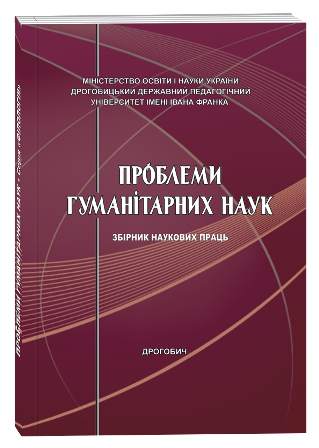“A DEATH IS ALWAYS EXCITING”: (POST)MODERN PATHOPOETICS OF THE WASP FACTORY BY IAIN BANKS
DOI:
https://doi.org/10.24919/2522-4565.2023.56.1Keywords:
postmodernism, Scottish fiction, pathopoetics, narrative structure, psychopathic character.Abstract
Summary. The article delves into an examination of the poetics of behavioral disorders in Iain Banks’s novel “The Wasp Factory” (1984), providing a masterfully crafted narrative of the life of a psychopath with distorted gender identity. The historiographical analysis reveals that this is the first instance of scrutinizing the first published novel of the Scottish writer through this particular lens. The methodology of the study is shaped by the specificity of the subject and its purpose. It draws upon contemporary Ukrainian and Western European literary studies exploring postmodern aesthetics, with a focus on marginality and deviations. Additionally, insights from studies clarifying psychopathologies, their signs, and causes further contribute to the analysis. The study determines that a distinctive aspect of “The Wasp Factory” lies in its adherence to postmodern stylistic trends while concurrently attempting to resist this influence. Moreover, the pathopoetics of the work combines grotesque situations and black humour with the truly tragic story of the protagonist’s mental disorder. The author’s intent is realized not solely in the content but also on the formal level, particularly through the specific composition organization and narrative structure of the novel. The narrative technique emerges as a crucial means of influencing the reader, as the story is narrated from the protagonist’s perspective, offering a unique and often bizarre viewpoint that disrupts the automaticity of reader perception. The reader is subtly compelled to sympathize with a brutal murderer and psychopath. Overall, “The Wasp Factory” showcases Iain Banks’s exceptional ability to cater to the tastes of both the average mass and the intellectual reader.
References
Сізова К. Готичний роман у літературі постмодернізму : традиційне й новаторське. Гуманітарна освіта в технічних вищих навчальних закладах. 2013. № 28. С. 254–269.
A Poetics of Neurosis : Narratives of Normalcy and Disorder in Cultural and Literary Texts / ed. by Furlanetto E., Dietmar M. Bielefeld : Transcript, 2019. 203 p. DOI: 10.14361/9783839441329
Alegre S. M. Consider Banks : Iain (M.) Banks’s “The Wasp Factory” and “Consider Phlebas”. Revista Canaria de Estudios Ingleses. 2000. Volume 41. P. 197–205.
Banks I. The Wasp Factory. NY : Simon & Schuster, 1984. 184 p.
Briedik A. Diagnosing and Comparing Mental Disorders of Serial Killers in Fiction : An Interdisciplinary Study of Iain Banks’ “The Wasp Factory” (1984) and Bret E. Ellis’ “American Psycho” (1991). The International Journal of Literary Humanities. 2022. Volume 20. Issue 1. P. 157–171. DOI: 10.18848/2327-7912/CGP/v20i01/157-171
Butler A. M. Strange Case of Mr. Banks : Doubles and “The Wasp Factory”. Foundation : The International Review of Science Fiction. 1999. Volume 28. Issue 76. P. 17–27.
Colebrook M. Reading Double, Writing Double : The Fiction of Iain (M.) Banks. The Bottle Imp. 2010. Volume 8. P. 1–6.
Duggan R. Iain Banks : improbable possibilities. The grotesque in contemporary British fiction. Manchester : Manchester University Press, 2013. P. 150–181.
Emmons R. A. Factor analysis and construct validity of the Narcissistic Personality Inventory. Journal of Personality Assessment. 1984. № 48. Р. 291–300.
Hutcheon L. Poetics of Postmodernism : History; Theory; Fiction. London & New York : Routledge, 1988. 284 p.
Jafari M., Beyad M. S., Ramin Z. The Warped Bildung : Parody, Postmodern Gothic, and the Bildungsroman in Iain Banks’s “The Wasp Factory”. Critique : Studies in Contemporary Fiction. 2023. 08 Sep. P. 1–14. DOI: 10.1080/00111619.2023.2255137
Kincaid P. Far Too Strange : The Early Fiction of Iain Banks. Foundation: The International Review of Science Fiction. 2013. Volume 42. Issue 116. P. 23–36.
Nairn T. Iain Banks and the Fiction Factory. The Scottish Novel since the Seventies: New Visions, Old Dreams / eds. G. Wallace, R. Stevenson. Edinburgh : Edinburgh University Press, 1993. P. 127–135.
Punter D. The Literature of Terror : Volume 2: The Modern Gothic. 2nd ed. London : Routledge, 1996. 248 p. DOI: 10.4324/9781315842158.
Roebuck O. Rejecting Limits and Opening Possibilities in the Works of Iain Banks. American & British Studies Annual. 2016. Volume 9. P. 44–54.
Schoene-Harwood B. Dams Burst : Devolving Gender in Iain Banks’s “The Wasp Factory”. ARIEL : A Review of International English Literature. 1999. Volume 30. Issue 1. P. 131–148.
Villa F. The Psychoanalytical Method and the Disaster of Totalitarianism : Borderline States as the Psychical Equivalent of the Discontent in Civilization? Critical Inquiry. 2014. № 40 (2). Р. 267–287.
Wink P. Two Faces of Narcissism. Journal of Personality and Social Psychology. 1991. № 61. Р. 590–597.



